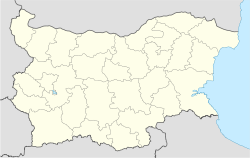Silistra
| Silistra Силистра |
|
 Silistra
|
|
| Coordinates: | |
| Country | |
|---|---|
| Provinces (Oblast) |
Silistra |
| Government | |
| - Mayor | Ivo Andonov |
| Elevation | 6 m (20 ft) |
| Population (2005-09-13) | |
| - Total | 49,166 |
| Time zone | EET (UTC+2) |
| - Summer (DST) | EEST (UTC+3) |
| Postal Code | 7500 |
| Area code(s) | 086 |
Silistra (Bulgarian: Силистра [si.'lis.trə], historically Bulgarian: Дръстър, Drastar, (['drəstər])) is a port city of northeastern Bulgaria, lying on the southern side of the lower Danube at the country's border with Romania. Silistra is the administrative centre of Silistra Province and one of the important cities of the historical region of Southern Dobruja.
Contents[hide] |
History
The Romans built a fortress in 29 AD on the site of an earlier Celtic settlement and kept its name, Durostorum (or Dorostorum). It became an important military centre of Moesia and grew into a city at the time of Marcus Aurelius. In 388, Durostorum became the seat of a Christian bishopric and a centre of Christianity in the region, and Roman general Flavius Aëtius was born in the town in 396. After the Roman Empire was split, the town (known as Δουρόστολον, Durostolon in Byzantine Greek) became part of the Byzantine Empire.

Around the end of the 7th century, the town was incorporated in the First Bulgarian Empire and the bishop of Drastar was proclaimed the first patriarch of Bulgaria. The town was captured by the forces of Sviatoslav I of Kiev in 969, but two years later it was besieged by the Byzantines during the Battle of Dorostolon. Having been ceded to the Byzantines, it was renamed Theodoropolis, after military saint Theodore Stratelates, who is said to have come to Emperor John I Tzimiskes' aid during the battle. In 976, Tsar Samuil restored Bulgarian rule in the region until 1001, when it was once again incorporated within the bounds of the Byzantine Empire.
In 1186, after the Vlach-Bulgarian Rebellion, the town became part of the Second Bulgarian Empire until the Ottoman conquest of Bulgaria in 1396.
During Ottoman rule, Silistra (Silistre in Ottoman Turkish) was part of Rumelia Province and was the administrative centre of the Silistra sanjak. This sanjak was later upgraded to become the Silistra Province that stretched over most of the western Black Sea littoral. The town was captured by Russian forces numerous times during several Russo-Turkish Wars.
In 1878, following the Russo-Turkish War of 1877–1878, Silistra was included in the newly autonomous Principality of Bulgaria, which became the Kingdom of Bulgaria in 1908.
In May 1913, after unsuccessful Bulgarian-Romanian negotiations in London, the two countries accepted the mediation of the Great Powers, who awarded Silistra and the area in a 3 km radius around it to Romania at the Saint Petersburg Conference. Following the Second Balkan War, the Treaty of Bucharest (1913) granted Silistra and the whole of Southern Dobruja to Romania. Although Bulgaria regained the town during World War I with the Treaty of Bucharest (1918), in which Romania surrendered to the Central Powers (including Bulgaria), the Treaty of Neuilly (1919) following World War I returned it to Romania. Silistra remained a part of Romania until the Axis-sponsored Treaty of Craiova of 1940, when the town once again became part of Bulgaria, a transfer confirmed by the Paris Peace Treaties of 1947.
Historical population
| Year | Population |
|---|---|
| 1888 | 11,414 |
| 1892 | 11,718 |
| 1900 | 12,133 |
| 1908 | 12,055 |
| 1924 | 13,756 |
| 1974 | 48,000 |
| 1985 | 53,500 |
| 2005 | 49,166 |
Honour
Silistra Knoll on Livingston Island in the South Shetland Islands, Antarctica is named after Silistra.
External links
- News from UNESCO nature reserve in Silistra
- Official municipality website (in Bulgarian and English)
- Silistra article at Pictures Of Bulgaria
|
|||
|
||

